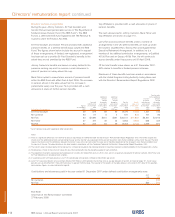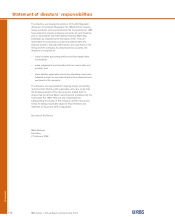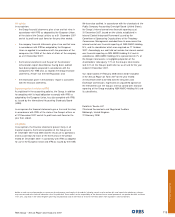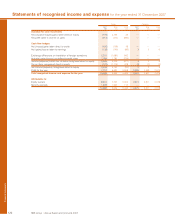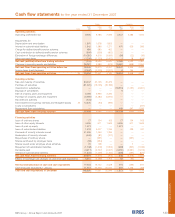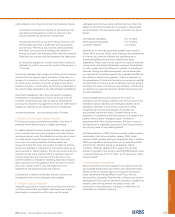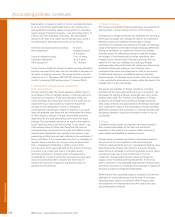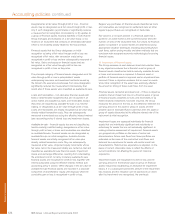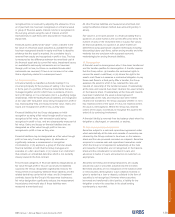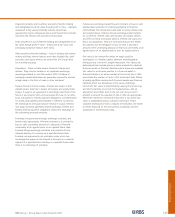RBS 2007 Annual Report Download - page 126
Download and view the complete annual report
Please find page 126 of the 2007 RBS annual report below. You can navigate through the pages in the report by either clicking on the pages listed below, or by using the keyword search tool below to find specific information within the annual report.
RBS Group • Annual Report and Accounts 2007
124
Accounting policies
Financial statements
1. Presentation of accounts
The accounts are prepared in accordance with International
Financial Reporting Standards issued by the International
Accounting Standards Board (“IASB”) and interpretations
issued by the International Financial Reporting Interpretations
Committee of the IASB (together “IFRS”) as adopted by the
European Union (“EU”). The EU has not adopted the complete
text of IAS 39 ‘Financial Instruments: Recognition and
Measurement’; it has relaxed some of the standard’s hedging
requirements. The Group has not taken advantage of this
relaxation and has adopted IAS 39 as issued by the IASB: the
Group’s financial statements are prepared in accordance with
IFRS as issued by the IASB. The date of transition to IFRS for
the Group and the company (The Royal Bank of Scotland
Group plc) and the date of their opening IFRS balance sheets
was 1 January 2004.
The Group has adopted IFRS 7 ‘Financial Instruments:
Disclosures’ for the accounting period beginning 1 January
2007. This has had no effect on the results, cash flows or
financial position of the Group or the company. However, there
are changes to the notes on the accounts and comparative
information is presented accordingly.
The Group is no longer required to include reconciliations of
shareholders’ equity and net income under IFRS and US GAAP
in its filings with the Securities and Exchange Commission in
the US.
The company is incorporated in the UK and registered in
Scotland. The accounts are prepared on the historical cost
basis except that the following assets and liabilities are stated
at their fair value: derivative financial instruments, held-for-
trading financial assets and financial liabilities, financial assets
and financial liabilities that are designated as at fair value
through profit or loss, available-for-sale financial assets and
investment property. Recognised financial assets and financial
liabilities in fair value hedges are adjusted for changes in fair
value in respect of the risk that is hedged.
The company accounts are presented in accordance with the
Companies Act 1985.
2. Basis of consolidation
The consolidated financial statements incorporate the financial
statements of the company and entities (including certain
special purpose entities) that continue to be controlled by the
Group (its subsidiaries). Control exists where the Group has
the power to govern the financial and operating policies of the
entity; generally conferred by holding a majority of voting
rights. On acquisition of a subsidiary, its identifiable assets,
liabilities and contingent liabilities are included in the
consolidated accounts at their fair value. Any excess of the
cost (the fair value of assets given, liabilities incurred or
assumed and equity instruments issued by the Group plus any
directly attributable costs) of an acquisition over the fair value
of the net assets acquired is recognised as goodwill. The
interest of minority shareholders is stated at their share of the
fair value of the subsidiary’s net assets.
The results of subsidiaries acquired are included in the
consolidated income statement from the date control passes
to the Group. The results of subsidiaries are included up until
the Group ceases to control them through a sale or significant
change in circumstances.
All intra-group balances, transactions, income and expenses
are eliminated on consolidation. The consolidated accounts are
prepared using uniform accounting policies.
3. Revenue recognition
Interest income on financial assets that are classified as loans
and receivables, available-for-sale or held-to-maturity and
interest expense on financial liabilities other than those at fair
value through profit or loss are determined using the effective
interest method. The effective interest method is a method of
calculating the amortised cost of a financial asset or financial
liability (or group of financial assets or liabilities) and of
allocating the interest income or interest expense over the
expected life of the asset or liability. The effective interest rate
is the rate that exactly discounts estimated future cash flows to
the instrument’s initial carrying amount. Calculation of the
effective interest rate takes into account fees payable or
receivable, that are an integral part of the instrument’s yield,
premiums or discounts on acquisition or issue, early
redemption fees and transaction costs. All contractual terms of
a financial instrument are considered when estimating future
cash flows.
Financial assets and financial liabilities held-for-trading or
designated as at fair value through profit or loss are recorded
at fair value. Changes in fair value are recognised in profit or
loss together with dividends and interest receivable and payable.
Commitment and utilisation fees are determined as a
percentage of the outstanding facility. If it is unlikely that a
specific lending arrangement will be entered into, such fees
are taken to profit or loss over the life of the facility otherwise
they are deferred and included in the effective interest rate on
the advance.
Fees in respect of services are recognised as the right to
consideration accrues through the provision of the service to
the customer. The arrangements are generally contractual and
the cost of providing the service is incurred as the service is
rendered. The price is usually fixed and always determinable.
The application of this policy to significant fee types is outlined
below.
Payment services: this comprises income received for payment
services including cheques cashed, direct debits, Clearing
House Automated Payments (the UK electronic settlement
system) and BACS payments (the automated clearing house
that processes direct debits and direct credits). These are
generally charged on a per transaction basis. The income is
earned when the payment or transaction occurs. Charges for
payment services are usually debited to the customer’s
account, monthly or quarterly in arrears. Accruals are raised
for services provided but not charged at period end.


